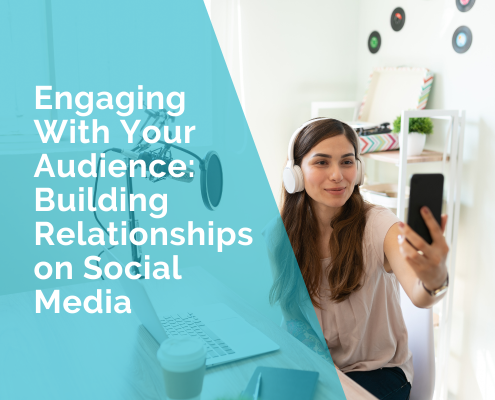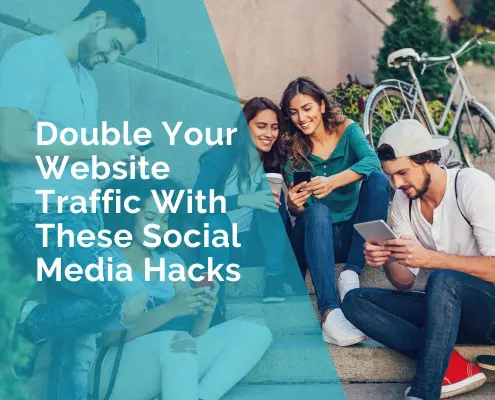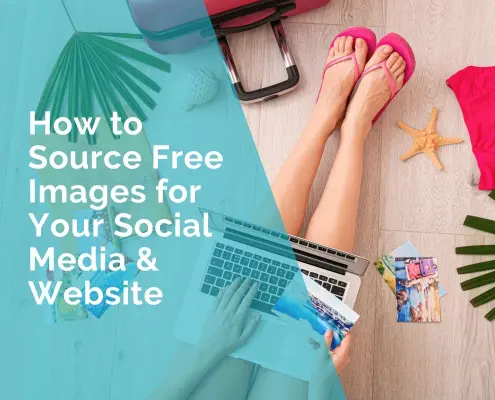Why Branding Matters
Imagine this, someone stumbles upon your Instagram, clicks over to your website, and then ends up on your Facebook page.
What’s the one thing that ties it all together? Your branding, of course!
When your brand maintains a consistent look, feel, and message across all platforms, you’re not just creating an aesthetic harmony; you’re building a strong foundation for recognition, trust, and engagement.
Imagine a potential customer recognizing your logo or colour scheme from a distance – that’s the result of a carefully cultivated consistent branding strategy.
From colours and fonts to the tone of your messaging, it’s about creating a familiar and reassuring environment for your audience to connect with and remember.
Consistency isn’t just a buzzword; it’s the fuel that propels your brand forward in the digital landscape.
Here’s why it matters:
1. Instant Recognition
Think of your branding as your digital signature. Whether it’s your logo, colour palette, or even your tone of voice, when it’s consistent across platforms, your audience can spot you from a mile away. Familiarity breeds trust, and that’s a big win.
2. Professionalism 101
A cohesive look and feel give off a professional vibe. It shows that you’ve put thought into your brand’s presentation and that you take your online presence seriously. That’s the kind of impression that gets you noticed in the right way.
3. Stronger Recall
Let’s face it, we’re bombarded with information every second online. Consistent branding helps your brand stick in people’s minds. When they think about a certain colour or a catchy tagline, your brand should be what comes to mind.
4. Storytelling Magic
Your brand tells a story – it’s a glimpse into your mission, values, and what you stand for.
Consistency in storytelling across platforms helps your audience connect the dots and get a full picture of who you are.
So, how can you keep that branding game strong?
1. Logo Love
Your logo is your brand’s face. Make sure it’s displayed consistently on all your platforms – from your website header to your social media profile pictures.

2. Colour Charm
Stick to a specific colour palette. Use the same colours across your website, social media posts, and graphics. It’s amazing how colour can evoke emotions and create a lasting impact.
3. Fonts Are Friends
Pick a couple of fonts and stick with them. Whether it’s for your website text or social media captions, a consistent font adds a professional touch.
4. Voice and Tone
Your brand’s voice is its personality. Whether it’s witty, friendly, or formal, make sure your tone is consistent in your website copy, social media captions, and interactions.
Remember, it’s about creating a seamless experience for your audience. From the moment they land on your website to the time they engage with you on social media, the journey should feel like they’re in the same cozy corner of the internet.

Content is King
1. The Role of High-Quality Content in Driving Website Traffic
In the ever-evolving landscape of digital marketing, one adage remains unwaveringly true: “Content is king.” When it comes to driving website traffic through social media, the quality of your content plays a pivotal role.
Quality content not only attracts your target audience but also keeps them engaged, encourages sharing, and ultimately directs them to your website.
Here, we’ll delve into the significance of high-quality content in your social media strategy.
Effective content serves as a magnet for your audience, drawing them in and encouraging them to explore your website further.
When your social media posts are well-crafted, informative, and entertaining, they create a positive impression of your brand, positioning you as an authority in your niche.
2. Strategies for Creating Engaging and Shareable Content
Utilizing Multimedia (Images, Videos, Infographics)
Visual content reigns supreme on social media platforms. Incorporating multimedia elements such as images, videos, and infographics into your posts can significantly enhance engagement.
People are naturally drawn to visual content, and it’s more likely to be shared, expanding your reach.
To make the most of multimedia content:
- Ensure high-resolution images and videos.
- Craft visually appealing infographics that convey valuable information.
- Experiment with live videos, stories, and reels on platforms that support them.
Writing Compelling Headlines and Captions
The first thing that grabs a user’s attention on social media is often the headline or caption.
A compelling headline or caption should be concise, attention-grabbing, and relevant to the content it introduces.
Use persuasive language, ask questions, or create a sense of urgency to entice users to click through to your website.
Remember that clarity is crucial. Users should have a clear idea of what to expect when they click on your content.
Leveraging User-Generated Content
User-generated content (UGC) is a powerful tool for increasing engagement and trust.
Encourage your audience to create content related to your products or services and share it on their own social media accounts.
UGC not only provides authentic social proof but also allows you to leverage your existing customers as brand advocates.
To encourage user generated content:
- Run contests or giveaways with the condition of users creating and sharing content.
- Showcase UGC on your social media profiles to inspire others.
- Always ask for permission and give credit to the creators.
3. The Importance of Consistency in Content Creation and Posting
Consistency is a key driver of success in social media marketing.
Regular posting and maintaining a consistent brand voice help build familiarity and trust with your audience.
When users know what to expect from your content, they are more likely to engage with it.
To maintain consistency:
- Create a content calendar to plan and schedule posts in advance.
- Stick to a consistent posting schedule tailored to your audience’s online habits.
- Develop a style guide to ensure a uniform brand voice and aesthetic.
High-quality content is the cornerstone of any successful social media strategy aimed at driving website traffic. It not only attracts and engages your audience but also encourages them to take the desired action of visiting your website.
Utilize Hashtags Effectively
Hashtags are a fundamental element of social media marketing, playing a pivotal role in expanding the reach of your content and increasing its discoverability.
When used effectively, hashtags can help you connect with a broader audience and drive website traffic.
In this section, we’ll explore how to effectively utilize hashtags on various social media platforms, backed by research-based tips and best practices.
1. Explanation of How Hashtags Work on Different Social Media Platforms
Twitter: On Twitter, hashtags are used to categorize tweets and make them discoverable to users interested in specific topics. Tweets with relevant hashtags are more likely to appear in search results and trending topics. Twitter users often engage with trending hashtags, making it a powerful platform for real-time conversations.
Instagram: Instagram relies heavily on hashtags for content discovery. Users can follow specific hashtags, explore content related to their interests, and discover new accounts. Instagram allows for the use of up to 30 hashtags per post, making it essential to choose them wisely.
Facebook: While hashtags are not as central to Facebook as they are on Twitter and Instagram, they are still valuable. They help categorize content and make it discoverable to users interested in a particular topic. Facebook also provides insights into hashtag performance.
LinkedIn: LinkedIn has adopted hashtags to facilitate content discovery and engagement. Users can follow and search for relevant hashtags, making it essential for businesses and professionals to use them strategically to reach their target audience.
2. Research-Based Tips for Finding and Using Relevant Hashtags
Research Popular and Niche Hashtags
To find relevant hashtags, use social media analytics tools and platforms like Hashtagify, RiteTag, or the built-in search functions on each platform. Identify popular and trending hashtags within your industry or niche.
Mix Broad and Specific Hashtags
Incorporate a mix of broad and specific hashtags in your posts. Broad hashtags like #marketing or #travel can reach a wide audience, while specific ones like #DigitalMarketingTips or #SoloTravelEurope can connect you with a more targeted audience.
Monitor Competitors
Analyze the hashtags your competitors are using successfully. These can provide insights into which hashtags resonate with your target audience.
Create Branded Hashtags
Develop unique, branded hashtags related to your business or campaigns. Branded hashtags can help build brand identity and encourage user-generated content.
Check Hashtag Relevance
Ensure that the hashtags you use are directly related to your content. Misusing unrelated hashtags can harm your credibility and reach.
Stay Current
Keep an eye on trending hashtags and leverage them when relevant. However, be cautious not to force unrelated content into trending conversations.
3. Avoiding Hashtag Overuse and Spammy Practices
Limit the Number of Hashtags
While some platforms allow multiple hashtags, avoid overloading your posts with them. A few well-chosen hashtags are generally more effective than an excessive number.
Use Relevant Hashtags
Ensure that the hashtags you use are directly related to your content. Overusing irrelevant hashtags can lead to your posts being marked as spam.
Avoid Gimmicky or Overused Hashtags
Overused and generic hashtags like #instagood or #followme may not yield meaningful engagement and can make your content appear spammy.
Monitor Hashtag Performance
Regularly review the performance of your posts with different hashtags. Analyze which ones drive the most engagement and traffic to your website, and adjust your strategy accordingly.
Hashtags are a valuable tool for expanding the reach of your social media content and driving website traffic.
Understanding how they work on different platforms, conducting research to find relevant hashtags, and avoiding spammy practices are essential for effectively utilizing hashtags in your social media marketing strategy.
When used strategically, hashtags can help you connect with a broader and more engaged audience, ultimately leading to increased website traffic.

Timing is Everything
1. Discussion on the Importance of Posting at Optimal Times
Imagine you’ve prepared a beautifully crafted social media post – eye-catching visuals, witty copy, and a strong call to action. But if you post it at a time when your target audience isn’t online, it’s like shouting in an empty room. Timing is crucial in social media, and here’s why:
Maximizing Visibility
Posting when your audience is most active ensures that your content appears in their feeds when they’re scrolling. This increases the chances of your post being seen and engaged with.
Competitive Advantage
Timing can give you a competitive edge. If you’re the first to share breaking news or trends in your industry, you’re more likely to grab your audience’s attention.
2. Research-Backed Insights into the Best Times to Post on Various Platforms
Instagram: According to research, the best times to post on Instagram are typically between 9 AM to 11 AM and 1 PM to 3 PM on weekdays. Engagement tends to drop during late-night hours and on weekends.
Facebook: Weekdays from 9 AM to 3 PM are generally considered ideal for Facebook posts. Thursdays and Fridays often see higher engagement rates.
Twitter: Twitter is known for its fast-paced nature, so multiple posts throughout the day can be effective. However, engagement often peaks around noon and 5-6 PM.
LinkedIn: For LinkedIn, posting during business hours, particularly on Tuesdays, Wednesdays, and Thursdays, tends to yield better results. Avoid weekends and late evenings.
Pinterest: Pinterest users are often active in the evenings, with 8 PM to 11 PM being a prime time for pinning. Saturdays are usually the best day to post.
3. The Role of Scheduling Tools and Analytics in Timing Your Posts
Scheduling tools like Hootsuite, Buffer, and Sprout Social are invaluable for optimizing your social media timing. They allow you to plan and schedule posts for the most appropriate times, even if your audience is in a different time zone.
Additionally, social media analytics provide insights into when your audience is most active and when your posts receive the most engagement. Platforms like Instagram and Facebook offer in-depth analytics that can help you refine your posting schedule.
For instance, you might notice that your Instagram audience is most active on weekdays from 5 PM to 8 PM. Armed with this data, you can schedule your posts accordingly to maximize their impact.
Understanding when your target audience is most active on different social media platforms and using scheduling tools and analytics to fine-tune your posting schedule can significantly enhance the effectiveness of your social media strategy. Timing your posts well ensures that your content reaches the right people at the right moment, increasing engagement and driving website traffic.
Engage with Your Audience
1. Building and Nurturing Relationships with Your Followers
Social media is not just a megaphone for broadcasting your message; it’s a two-way street. Building and nurturing relationships with your followers is paramount to a successful social media strategy. Here’s how:
Authenticity
Be authentic in your interactions. Show the human side of your brand. Respond to comments and messages in a friendly and personalized manner.
Active Listening
Pay attention to what your followers are saying. Monitor mentions and conversations related to your brand. Engage in discussions and address concerns promptly.
Acknowledgment
Recognize and celebrate your loyal followers. Feature user-generated content or create shout-out posts to show appreciation.
2. Strategies for Responding to Comments and Messages Promptly
Timely Responses
Aim to respond to comments and messages within a reasonable timeframe, ideally within a few hours. Swift responses demonstrate that you value your audience’s input.
Personalization
Avoid generic or automated responses. Personalize your replies by addressing users by their names and directly addressing their questions or comments.
Handling Negative Feedback
Negative comments or reviews can be challenging. Address them calmly, professionally, and privately when possible. Show your willingness to resolve issues.
3. Running Interactive Social Media Campaigns and Contests
Interactive campaigns and contests are fantastic ways to engage your audience and drive traffic to your website. Consider these strategies:
Contests
Host creative contests that encourage user participation. For example, if you run a fitness blog, you could have a “Best Transformation” contest where users submit their before-and-after photos.
Polls and Surveys
Engage your audience by asking for their opinions. This not only encourages interaction but also provides valuable insights for your business.
Live Q&A Sessions
Host live question-and-answer sessions where your audience can ask you questions in real-time. This fosters a sense of community and provides an opportunity to showcase your expertise.
In essence, engagement on social media is about building relationships, listening to your audience, and creating a sense of community. By actively engaging with your followers, you not only increase their loyalty but also drive traffic to your website through meaningful connections.

Cross-Promotion and Collaboration
1. Exploring Opportunities for Cross-Promotion with Influencers or Complementary Brands
Cross-promotion involves collaborating with individuals or brands with a similar target audience to mutually promote each other’s content or products. Here’s why it’s effective:
Shared Audiences
When you partner with someone in your niche, you gain access to their established audience, which is likely interested in what you offer.
Credibility and Trust
Recommendations from trusted sources, such as influencers or complementary brands, carry significant weight and can boost your credibility.
For example, if you have a sustainable fashion brand, collaborating with a popular eco-friendly lifestyle influencer could introduce your products to a receptive audience already interested in sustainability.
2. How Collaboration Can Help You Tap into New Audiences
Influencer Partnerships
Identify influencers whose values align with your brand. Collaborate with them to create content that showcases your products or services. Influencers can introduce your brand to their followers in an authentic and engaging way.
Guest Posts and Takeovers
Partner with complementary brands or industry experts for guest blog posts or social media takeovers. This not only diversifies your content but also exposes your brand to a new audience.
Joint Webinars or Events
Co-hosting webinars, virtual events, or workshops with others in your industry can help you reach a broader audience and share expertise.
3. Case Studies of Successful Cross-Promotion Campaigns
Nike + Apple
The partnership between Nike and Apple produced the Nike Training Club app, which integrates with Apple Watch. It allowed both brands to tap into each other’s audiences, with Nike gaining access to Apple’s tech-savvy user base.
Burt’s Bees + National Geographic
Burt’s Bees collaborated with National Geographic on a campaign called “Bring Back the Bees.” This partnership raised awareness about bee conservation and aligned with both brands’ values, resonating with environmentally conscious consumers.
GoPro + Red Bull
GoPro and Red Bull partnered to create thrilling extreme sports content. Red Bull is known for its adrenaline-pumping events, and GoPro’s cameras capture the action up close. Together, they produced jaw-dropping videos that showcased both the GoPro brand and the excitement of Red Bull events. This collaboration not only expanded the reach of both brands but also enhanced their image as purveyors of adventure and excitement.

Starbucks + Spotify
Starbucks and Spotify teamed up to create curated playlists that played in Starbucks stores. Customers could also access these playlists through the Starbucks app. This partnership provided Starbucks with a unique way to enhance the in-store experience and introduced Spotify users to Starbucks’ music choices, potentially driving them to visit a nearby store.
These case studies illustrate how cross-promotion and collaboration can be a win-win strategy. By strategically aligning with influencers, complementary brands, or even organizations that share your values and target audience, you can leverage their reach and credibility to boost your social media presence and ultimately drive more traffic to your website.
It’s important to remember that the digital landscape is constantly evolving, and your website’s success is an ongoing journey. By implementing the strategies and tips discussed here, you have the tools to transform your online presence and connect with a wider audience. Stay committed, adapt to the changing landscape, and watch your website traffic thrive. Happy posting!
Frequently Asked Questions about Driving Traffic to a Website Using Social Media
What is social media traffic, and why is it important for my website?
Social media traffic refers to the visitors that come to your website through links shared on social media platforms. It’s important because it can increase your website’s visibility, reach a wider audience, and potentially convert visitors into customers or followers.
Which social media platforms should I focus on for driving website traffic?
The choice of platforms depends on your target audience and content. However, popular options include Facebook, Instagram, Twitter, LinkedIn, Pinterest, and TikTok.
How can I optimize my social media profiles to drive more traffic?
To optimize your profiles, ensure they are complete, have clear branding, and include a link to your website. Use keywords relevant to your niche in your bio, and post engaging content regularly.
What types of content work best for driving traffic on social media?
Content that tends to perform well includes blog posts, videos, infographics, and user-generated content. Experiment with different formats to see what resonates with your audience.
Should I schedule my social media posts for specific times or days?
Yes, scheduling posts at times when your target audience is most active can boost engagement. Use social media analytics tools to determine the best times to post for your audience.
Do paid social media ads help drive traffic to my website?
Yes, paid ads on platforms like Facebook, Instagram, and Twitter can be effective in driving traffic. They allow you to target specific demographics and interests to reach a relevant audience.
How can I encourage social media users to click on my website links?
Craft compelling captions and headlines, use eye-catching visuals, and employ strong calls to action (CTAs) to entice users to click on your links. Offering incentives or exclusive content can also be effective.
What are some common mistakes to avoid when using social media to drive website traffic?
Common mistakes include overposting, not optimizing content for each platform, neglecting analytics, and being too promotional. Avoiding these pitfalls can help you succeed.
How can I measure the effectiveness of my social media efforts in driving website traffic?
You can measure effectiveness through website analytics tools like Google Analytics, tracking click-through rates (CTR) on social media links, monitoring social media engagement metrics, and setting specific goals and KPIs for your social media campaigns.
 Ivana Katz from Websites 4 Small Business is an award winning web designer who builds websites that build your business. She provides unbeatable web design services to fit your budget.
Ivana Katz from Websites 4 Small Business is an award winning web designer who builds websites that build your business. She provides unbeatable web design services to fit your budget.
The end result? Professional, custom-made sites that give your business the extra oomph it needs to stand out from the competition and make an impact.
Whether you’re a brand-new business or an established one ready to improve your digital presence, Ivana makes it easy to get your business online very quickly. Her websites are professional, tailored to fit your budget, and give your business a serious boost.
Download your FREE copy of “Ultimate Website Design Secrets Blackbook – 10 Bulletproof Strategies for Designing an Outrageously Successful Website”














